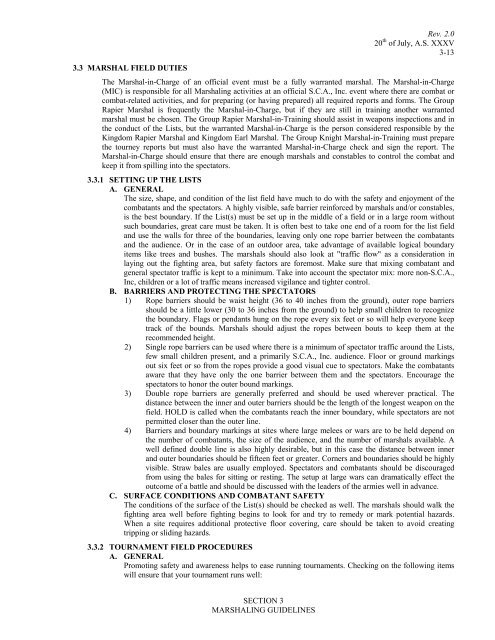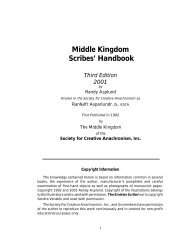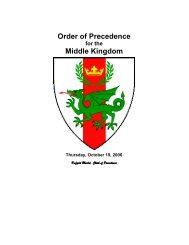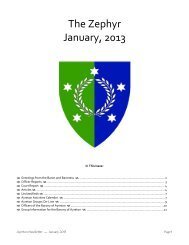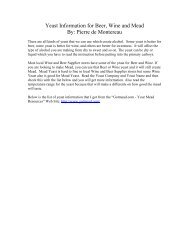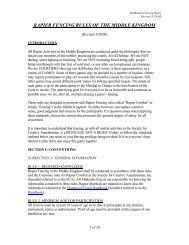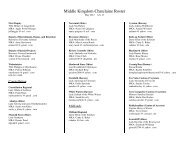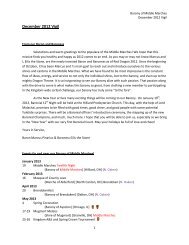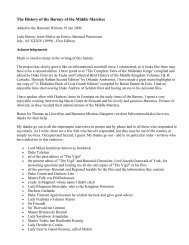Rapier Marshals Handbook - Midrealm / Middle Kingdom
Rapier Marshals Handbook - Midrealm / Middle Kingdom
Rapier Marshals Handbook - Midrealm / Middle Kingdom
Create successful ePaper yourself
Turn your PDF publications into a flip-book with our unique Google optimized e-Paper software.
SECTION 3<br />
MARSHALING GUIDELINES<br />
Rev. 2.0<br />
20 th of July, A.S. XXXV<br />
3-13<br />
3.3 MARSHAL FIELD DUTIES<br />
The Marshal-in-Charge of an official event must be a fully warranted marshal. The Marshal-in-Charge<br />
(MIC) is responsible for all Marshaling activities at an official S.C.A., Inc. event where there are combat or<br />
combat-related activities, and for preparing (or having prepared) all required reports and forms. The Group<br />
<strong>Rapier</strong> Marshal is frequently the Marshal-in-Charge, but if they are still in training another warranted<br />
marshal must be chosen. The Group <strong>Rapier</strong> Marshal-in-Training should assist in weapons inspections and in<br />
the conduct of the Lists, but the warranted Marshal-in-Charge is the person considered responsible by the<br />
<strong>Kingdom</strong> <strong>Rapier</strong> Marshal and <strong>Kingdom</strong> Earl Marshal. The Group Knight Marshal-in-Training must prepare<br />
the tourney reports but must also have the warranted Marshal-in-Charge check and sign the report. The<br />
Marshal-in-Charge should ensure that there are enough marshals and constables to control the combat and<br />
keep it from spilling into the spectators.<br />
3.3.1 SETTING UP THE LISTS<br />
A. GENERAL<br />
The size, shape, and condition of the list field have much to do with the safety and enjoyment of the<br />
combatants and the spectators. A highly visible, safe barrier reinforced by marshals and/or constables,<br />
is the best boundary. If the List(s) must be set up in the middle of a field or in a large room without<br />
such boundaries, great care must be taken. It is often best to take one end of a room for the list field<br />
and use the walls for three of the boundaries, leaving only one rope barrier between the combatants<br />
and the audience. Or in the case of an outdoor area, take advantage of available logical boundary<br />
items like trees and bushes. The marshals should also look at "traffic flow" as a consideration in<br />
laying out the fighting area, but safety factors are foremost. Make sure that mixing combatant and<br />
general spectator traffic is kept to a minimum. Take into account the spectator mix: more non-S.C.A.,<br />
Inc, children or a lot of traffic means increased vigilance and tighter control.<br />
B. BARRIERS AND PROTECTING THE SPECTATORS<br />
1) Rope barriers should be waist height (36 to 40 inches from the ground), outer rope barriers<br />
should be a little lower (30 to 36 inches from the ground) to help small children to recognize<br />
the boundary. Flags or pendants hung on the rope every six feet or so will help everyone keep<br />
track of the bounds. <strong>Marshals</strong> should adjust the ropes between bouts to keep them at the<br />
recommended height.<br />
2) Single rope barriers can be used where there is a minimum of spectator traffic around the Lists,<br />
few small children present, and a primarily S.C.A., Inc. audience. Floor or ground markings<br />
out six feet or so from the ropes provide a good visual cue to spectators. Make the combatants<br />
aware that they have only the one barrier between them and the spectators. Encourage the<br />
spectators to honor the outer bound markings.<br />
3) Double rope barriers are generally preferred and should be used wherever practical. The<br />
distance between the inner and outer barriers should be the length of the longest weapon on the<br />
field. HOLD is called when the combatants reach the inner boundary, while spectators are not<br />
permitted closer than the outer line.<br />
4) Barriers and boundary markings at sites where large melees or wars are to be held depend on<br />
the number of combatants, the size of the audience, and the number of marshals available. A<br />
well defined double line is also highly desirable, but in this case the distance between inner<br />
and outer boundaries should be fifteen feet or greater. Corners and boundaries should be highly<br />
visible. Straw bales are usually employed. Spectators and combatants should be discouraged<br />
from using the bales for sitting or resting. The setup at large wars can dramatically effect the<br />
outcome of a battle and should be discussed with the leaders of the armies well in advance.<br />
C. SURFACE CONDITIONS AND COMBATANT SAFETY<br />
The conditions of the surface of the List(s) should be checked as well. The marshals should walk the<br />
fighting area well before fighting begins to look for and try to remedy or mark potential hazards.<br />
When a site requires additional protective floor covering, care should be taken to avoid creating<br />
tripping or sliding hazards.<br />
3.3.2 TOURNAMENT FIELD PROCEDURES<br />
A. GENERAL<br />
Promoting safety and awareness helps to ease running tournaments. Checking on the following items<br />
will ensure that your tournament runs well:


